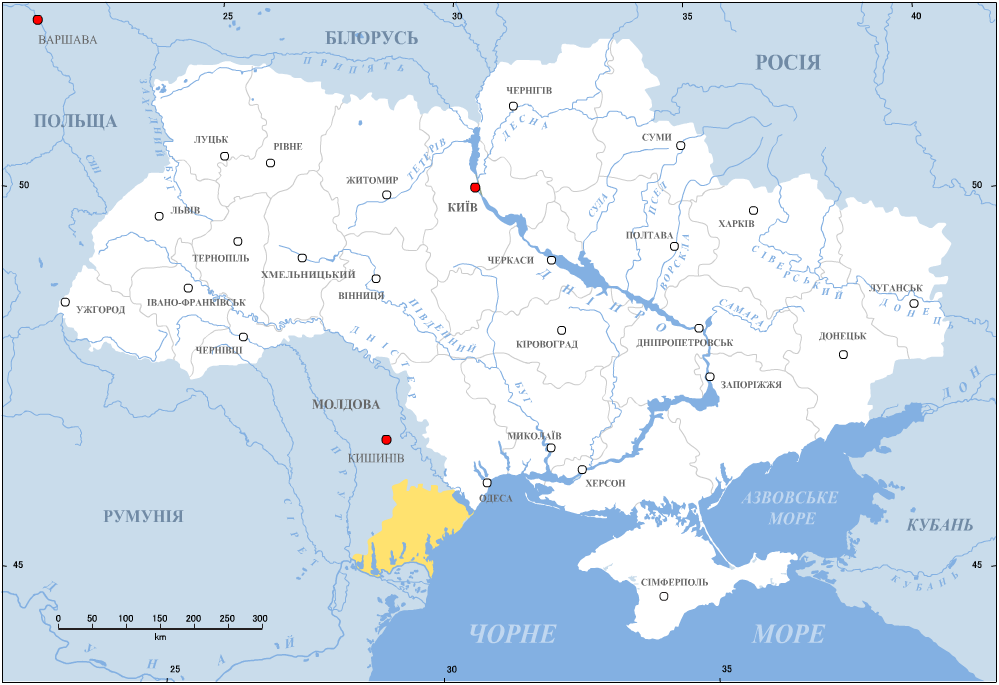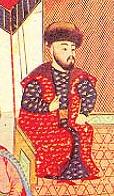|
─×az─▒ III Giray
Gazi III Giray (lived 1674ŌĆō1708, reigned 1704ŌĆō1707) was a khan of the Crimean Khanate. He was the second son of Selim I Giray. His brothers were khans Saadet IV Giray, Mengli II Giray, Devlet II Giray, Qaplan I Giray and Selyamet II Giray. None of his sons were khans. He succeeded his father Selim and was followed by his brother Qaplan. During his father's third reign (1692ŌĆō1699) he was serasker of the Budjak Horde. In 1699 his father resigned and was replaced by Gazi's older brother Devlet II Giray Devlet II Giray (1648ŌĆō1718) was Khan of the Crimean Khanate from 1699 to 1702 and from 1709 to 1713. His eldest son was Selim II Giray. First Rule (1699ŌĆō1702) Selim I Giray, after his retirement in 1699, recommended Devlet II Giray Khan .... Gazi was made nureddin. He and the Budjaks rose against his brother and after their defeat he was exiled to Rhodes. Devlet was deposed in 1702 and Gazi's father became khan for the fourth time. Gazi was made his kalga. In Dece ... [...More Info...] [...Related Items...] OR: [Wikipedia] [Google] [Baidu] |
Crimean Khanate
The Crimean Khanate ( crh, , or ), officially the Great Horde and Desht-i Kipchak () and in old European historiography and geography known as Little Tartary ( la, Tartaria Minor), was a Crimean Tatars, Crimean Tatar state existing from 1441 to 1783, the longest-lived of the Turkic khanates that succeeded the empire of the Golden Horde. Established by Hac─▒ I Giray in 1441, it was regarded as the direct heir to the Golden Horde and to Cumania, Desht-i-Kipchak. In 1783, violating the 1774 Treaty of K├╝├¦├╝k Kaynarca (which had guaranteed non-interference of both Russia and the Ottoman Empire in the affairs of the Crimean Khanate), the Russian Empire Annexation of Crimea by the Russian Empire, annexed the khanate. Among the European powers, only France came out with an open protest against this act, due to the longstanding Franco-Ottoman alliance. Naming and geography Crimean khans, considering their state as the heir and legal successor of the Golden Horde and Desht-i Kipchak, ... [...More Info...] [...Related Items...] OR: [Wikipedia] [Google] [Baidu] |
Selim I Giray
Selim I Giray, Selim Khan Girai ( crh, I Selim Geray, tr, 1. Selim Giray) was four times khan of the Crimean Khanate in the period from 1671 to 1704. During this time Crimean khans were regularly appointed and replaced by the Ottomans. The main events of the period were the continuing conflicts in Ukraine, the Russian capture of Azov and the Great Turkish War during which the Turks were pushed back from Vienna to about the line of Belgrade. Unlike other khans of the period, he ruled well and had no conflicts with his nobles. He was born in 1631. Background Crimean khans were the direct descendants of Genghis Khan, the Mongol Emperor. After the death of Genghis Khan (1227) the empire was partitioned and the part in East Europe and Northwest Asia was named Golden Horde. The Golden Horde khans embraced Islam. That region which was also called Desht-i Qipchaq was the home of Kypchak Turks and the khanate was Turkified. In the early 15th century Golden Horde was further partiti ... [...More Info...] [...Related Items...] OR: [Wikipedia] [Google] [Baidu] |
Saadet IV Giray
"Saadet" is a Turkish feminine given name, meaning "Felicity." People with this name include: Given name *Saadet Aksoy (born 1983), Turkish-born actress *Saadet I Giray (1492ŌĆō1538), Khan of the Crimean Khanate *Saadet II Giray (?ŌĆō1587), Khan of the Crimean Khanate * Saadet ─░kesus Altan (1916ŌĆō2007), Turkish opera singer, vocal coach and opera director *Saadet ├¢zkan (born 1978), Turkish activist against child abuse *Saadet Y├╝ksel (born 1983), Turkish judge at the European Court of Human Rights {{given name Other uses *Felicity Party The Felicity Party ( tr, Saadet Partisi, SP) is an Islamist Turkish political party. It was founded in 2001, and mainly supported by conservative Muslims in Turkey. It was founded on 20 July 2001 after the Virtue Party (FP) was banned by the C ... ( tr, Saadet Partisi), an Islamist Turkish political party Turkish given names ... [...More Info...] [...Related Items...] OR: [Wikipedia] [Google] [Baidu] |
Devlet II Giray
Devlet II Giray (1648ŌĆō1718) was Khan of the Crimean Khanate from 1699 to 1702 and from 1709 to 1713. His eldest son was Selim II Giray. First Rule (1699ŌĆō1702) Selim I Giray, after his retirement in 1699, recommended Devlet II Giray Khan to the post who was confirmed in the rank of Khan by the Ottoman Empire. In the early years of his reign, he faced a conflict that broke out between his brothers and Kalga Nureddin for important positions within the Khanate. One participant in the dispute, Goran Gaza, fled to Bujak and there gathered around himself rebellious Nogays that had intended to leave the subordination of the Crimea. This rebellion was suppressed by Devlet II Giray. Soon Khan had difficulties with foreign states. The Ottoman Empire, which signed peace treaty with Moscow, ignored all the warnings of the Khan, who reported on the plans of Peter I of Russia to continue to wage war in the south. Devlet II Giray tried to organize an army against the will of the Ottoman ... [...More Info...] [...Related Items...] OR: [Wikipedia] [Google] [Baidu] |
Qaplan I Giray
Qaplan I Giray was three times khan of the Crimean Khanate. He was the son of Selim I Giray and thus one of the six brothers who ruled for most the period from 1699 to 1743. During his first reign he was defeated by the Kabardians. His second reign ended when he did not fully support the Turks in the Balkans. During his third reign Russia invaded Crimea and burned the capital. First Reign (1707ŌĆō1708) He came to the throne in 1707 following the deposition of his brother ─×az─▒ III Giray. His kalga and nureddin were his brothers Me├▒li II Giray and Maksud. Maksud soon died and was followed by Sahib, another brother. He sent Mengli to discuss things with the Circassians or Kabardians. Mengli was arrogant, the Kabardians attacked and killed many of his men, but Mengli escaped. Qaplan then led a large army against the rebellious Kabardians, including 3,000 Turks. The war was a disaster (Battle of Kanzhal, September 1708). He lost most of his men, including the Shirin and Mansur be ... [...More Info...] [...Related Items...] OR: [Wikipedia] [Google] [Baidu] |
Budjak Horde
The Budjak Horde or Belgorod Horde formed part of the Nogai Horde in the 17th and 18th centuries. It settled in the northern Black Sea coast area under protectorate of the Crimean Khanate and the Ottoman Empire's Sanjak of Ozu (Yedisan). Its capital was in C─āu╚Öeni. In the 1620s the horde migrated from the Pontic steppes to the steppes of the Budjak region. The Bilhorod Tatars (20,000-30,000) were nomadic herdsmen. They made forays for slaves and loot into Right-bank Ukraine and Moldavia. In 1770 the horde became a protectorate of the Russian Empire and soon after was dispersed through resettlement in the Azov steppes. From there its remnants emigrated to Turkey during the Crimean War of 1853-1856. Prominent leaders of the horde included Khan Temir (died 1637), who allegedly established the noble Moldavian family of Cantemire╚Öti. Leaders * 1603–1637 Khan Temir * Giray family with rank of Serasker References External links Bilhorod Hordeat the Encyclopedia of Ukra ... [...More Info...] [...Related Items...] OR: [Wikipedia] [Google] [Baidu] |
Kalga (title)
Kalga ( uk, ąÜą░ą╗ą│ą░ russian: ąÜą░ą╗ą│ą░ crh3, qal─¤a, ┘鞦┘äž║ž¦ ar, ┘āž¦┘äž║ž¦ tr, kalgay ka, ßāÖßāÉßāÜßāÆßāÉ) was the highest ranked official after the khan in the hierarchy of the Crimean Khanate. The title of kalga was introduced Law and Division of Power in the Crimean Khanate (1532-1774): With Special Reference to the Reign of Murad Giray (1678-1683), by Natalia Kr├│likowska-Jedli┼äska, 2018, publisher BRILL, ISBN 9004384324, 9789004384323 in 1486 by Me├▒li I Giray for his son Mehmed Geray in order to establish a firm order of succession to the throne. Prior to that, power in the Golden Horde was inherited by a senior member of the khan's family, which led to endless strife. This may have been Mengli's intention, but in later reigns the khanship usually went to one of the khan's relatives without much regard to who had been kalga. The khan, kalga and nureddin were always members of the Giray clan. From an early date the khans were confirmed by the Ottoman Sultan. Fr ... [...More Info...] [...Related Items...] OR: [Wikipedia] [Google] [Baidu] |
Karnobat
Karnobat ( bg, ąÜą░čĆąĮąŠą▒ą░čé ) is a town in the Burgas Province, Southeastern Bulgaria. It is the administrative centre of the homonymous Karnobat Municipality. According to the 2021 census, the town has a population of 16,483 inhabitants.https://nsi.bg/bg/content/2975/%D0%BD%D0%B0%D1%81%D0%B5%D0%BB%D0%B5%D0%BD%D0%B8%D0%B5-%D0%BF%D0%BE-%D0%BE%D0%B1%D0%BB%D0%B0%D1%81%D1%82%D0%B8-%D0%BE%D0%B1%D1%89%D0%B8%D0%BD%D0%B8-%D0%BC%D0%B5%D1%81%D1%82%D0%BE%D0%B6%D0%B8%D0%B2%D0%B5%D0%B5%D0%BD%D0%B5-%D0%B8-%D0%BF%D0%BE%D0%BB Geography Karnobat municipality is situated in the south-eastern part of Bulgaria, and it falls within the administrative boundaries of Burgas region. Rishki Passage links the municipality to north Bulgaria. The Karnobat-Aitos range of the Balkan Mountains is located in the northern part of the municipality. Hisar Hill raise to the south of the town of Karnobat. The territory of Karnobat municipality is , 87.37% of which is agricultural land, 9.81% forest land and ... [...More Info...] [...Related Items...] OR: [Wikipedia] [Google] [Baidu] |
List Of Crimean Khans
This is a list of khans of the Crimean Khanate, a state which existed in present-day southern Ukraine from 1441 until 1783. Crimean Tatars, although not a part of the Ukrainian Ethnic group, ethnos, are deeply interconnected, having ruled a large part of modern History of Ukraine, Ukraine over the span of 300 years. The position of Khan in Crimea was electoral and was picked by beys from four of the most noble families (also known as Qarachi beys: Argyns, Kipchaks, Shirins, and Baryns) at kurultai where the decision about a candidate was adopted.Giray - Khan dynasty of Crimea Khan's Palace website (unavailable currently). The newly elected Khan was raised on a white felt sheet and over him were read Islamic prayers, after that the Khan was triumphantly enthroned. [...More Info...] [...Related Items...] OR: [Wikipedia] [Google] [Baidu] |
18th-century Crimean Khans
The 18th century lasted from January 1, 1701 ( MDCCI) to December 31, 1800 ( MDCCC). During the 18th century, elements of Enlightenment thinking culminated in the American, French, and Haitian Revolutions. During the century, slave trading and human trafficking expanded across the shores of the Atlantic, while declining in Russia, China, and Korea. Revolutions began to challenge the legitimacy of monarchical and aristocratic power structures, including the structures and beliefs that supported slavery. The Industrial Revolution began during mid-century, leading to radical changes in human society and the environment. Western historians have occasionally defined the 18th century otherwise for the purposes of their work. For example, the "short" 18th century may be defined as 1715ŌĆō1789, denoting the period of time between the death of Louis XIV of France and the start of the French Revolution, with an emphasis on directly interconnected events. To historians who expand the ... [...More Info...] [...Related Items...] OR: [Wikipedia] [Google] [Baidu] |

